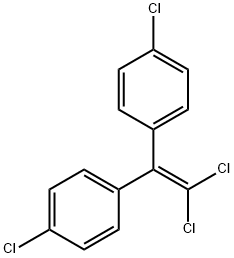
4,4'-ДДЕ
- английское имя4,4'-DDE
- CAS №72-55-9
- CBNumberCB9776968
- ФормулаC14H8Cl4
- мольный вес318.03
- EINECS200-784-6
- номер MDLMFCD00000837
- файл Mol72-55-9.mol
| Температура плавления | 88-90 °C(lit.) |
| Температура кипения | 403.45°C (rough estimate) |
| плотность | 1.3406 (rough estimate) |
| давление пара | 13 at 30 °C (Wescott et al., 1981) |
| показатель преломления | 1.6000 (estimate) |
| Fp | 11 °C |
| температура хранения | 2-8°C |
| растворимость | ethanol: soluble |
| форма | Solid |
| цвет | White, crystalline, odorless powder |
| Растворимость в воде | 292mg/L(25 ºC) |
| БРН | 1913355 |
| констант закона Генри | 0.33 at 25 °C (gas stripping-GC, Jantunen and Bidleman, 2006) |
| Стабильность | Stable, but light-sensitive. Incompatible with strong bases, strong oxidizing agents. |
| Рейтинг продуктов питания EWG | 3 |
| FDA UNII | 4M7FS82U08 |
| Система регистрации веществ EPA | p,p'-DDE (72-55-9) |
| UNSPSC Code | 41116107 |
| NACRES | NA.24 |
| Коды опасности | Xn,N,T,F | |||||||||
| Заявления о рисках | 22-40-50/53-52/53-39/23/24/25-23/24/25-11-67-65-38-51/53 | |||||||||
| Заявления о безопасности | 36/37-60-61-45-16-7-62-33-29-9 | |||||||||
| РИДАДР | UN 3077 9/PG 3 | |||||||||
| WGK Германия | 3 | |||||||||
| RTECS | KV9450000 | |||||||||
| Класс опасности | 9 | |||||||||
| Группа упаковки | III | |||||||||
| кода HS | 29036990 | |||||||||
| Банк данных об опасных веществах | 72-55-9(Hazardous Substances Data) | |||||||||
| Токсичность | Acute oral LD50 for rats 880 mg/kg (RTECS, 1985). | |||||||||
| NFPA 704: |
|
рисовальное письмо(GHS)
-
рисовальное письмо(GHS)



-
сигнальный язык
опасность
-
вредная бумага
H301:Токсично при проглатывании.
H372:Поражает органы в результате многократного или продолжительного воздействия.
H351:Предполагается, что данное вещество вызывает раковые заболевания.
H410:Чрезвычайно токсично для водных организмов с долгосрочными последствиями.
-
оператор предупредительных мер
P201:Беречь от тепла, горячих поверхностей, искр, открытого огня и других источников воспламенения. Не курить.
P273:Избегать попадания в окружающую среду.
P301+P310+P330:ПРИ ПРОГЛАТЫВАНИИ: Немедленно обратиться за медицинской помощью. Прополоскать рот.
4,4'-ДДЕ химические свойства, назначение, производство
Химические свойства
white crystalline powderИспользование
Military product; chemical research. Degradation product of p,p′-DDT.Определение
ChEBI: A chlorophenylethylene that is ethylene substituted by two 4-chlorophenyl groups at position 1 and two chlorine atoms at position 2.Общее описание
White crystalline solid or white powder.Реакции воздуха и воды
Insoluble in water.Профиль реактивности
4,4'-DDE is sensitive to exposure to light. 4,4'-DDE is incompatible with strong oxidizing agents and strong bases. Oxidation is catalyzed by UV radiation.Угроза здоровью
A derivative of DDT; structurally and toxicproperties are similar to those of DDT;however, the acute effects are somewhatmilder; moderately toxic by ingestion; ateratogenic substance; adequate evidence ofcarcinogenicity in experimental animalsLD50 oral (rat): 880 mg/kg
LD50 oral (mouse): 700 mg/kg.
Пожароопасность
Flash point data for 4,4'-DDE are not available. 4,4'-DDE is probably combustible.Профиль безопасности
Suspected carcinogen withexperimental carcinogenic and neoplastigenic data. Poisonby ingestion. Experimental reproductive effects. Mutationdata reported. An insecticide. When heated todecomposition it emits very toxic fumes of Cl-.Экологическая судьба
Biological. In four successive 7-day incubation periods, p,p′-DDE (5 and 10 mg/L) was recalcitrant to degradation in a settled domestic wastewater inoculum (Tabak et al.,1981).Photolytic. When an aqueous solution of p,p′-DDE (0.004uM) in natural water samples collected from California and Hawaii was irradiated (maximum λ= 240 nm) for 120 hours, 62% was photooxidized to p,p′-dichlorobenzophenone (Ross and Crosby, 1985).
When p,p′-DDE in water was irradiated at 313 nm, a quantum yield of 0.3 was achieved. A photolysis half-life of 0.9 days in summer and 6.1 days in winter by direct sunlight at 40° latitude was observed. Photolysis products included DDMU (yield 20%), o-chl
When p,p′-DDE in a methanol solvent was photolyzed at 260 nm, a dichloro-benzophenone, a dichlorobiphenyl, DDMU and 3,6-dichlorofluorenone (yield 10%) formed as the major products (Plimmer et al., 1970). Chemical/Physical. May degrade to bis(chlorophenyl)acetic acid (DDA) and hydrochloric acid in water (Verschueren, 1983) or oxidize to p,p′-dichlorobenzophenone using UV light as a catalyst (U.S. Department of Health and Human Services, 1989).
Методы очистки
Crystallise DDE from MeOH or EtOH and dry it in vacuo. The purity is checked by TLC. [G.tzi & Stammbach Helv Chim Acta 28 569 1946, Beilstein 5 H 639, 5 III1891.] POSSIBLE CARCINOGEN.4,4'-ДДЕ запасные части и сырье
запасной предмет
4,4'-ДДЕ поставщик
| поставщик | телефон | страна | номенклатура продукции | благоприятные условия |
|---|---|---|---|---|
| +86-29-81148696 +86-15536356810 |
China | 3882 | 58 | |
| +86-0371-86658258 +8613203830695 |
China | 29809 | 58 | |
| +1-781-999-5354 +1-00000000000 |
United States | 32161 | 58 | |
| +86-89586680 +86-13289823923 |
China | 8670 | 58 | |
| United States | 38631 | 58 | ||
| +86-852-30606658 | China | 43340 | 58 | |
| +1-+1(833)-552-7181 | United States | 57505 | 58 | |
| +86-0592-6210733 | China | 32343 | 55 | |
| 010-82848833 400-666-7788 |
China | 96815 | 76 | |
| 021-61259108 18621169109 |
China | 40228 | 62 |